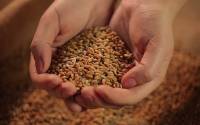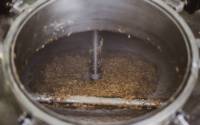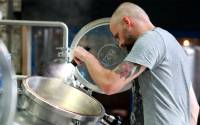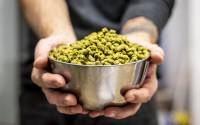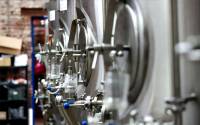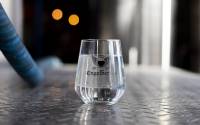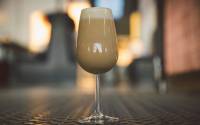1.SCRAPING
As with any trip, the brewing process also starts with a single step. Scraping the malt. Scraping is breaking open the malt grain and grinding the grain content.
We do this to release the starch. However, the shot must be done carefully and judiciously, because the malt must be coarsely ground. The chaff, which comes loose from the barley, must not be damaged. We will need this later in the process, when it will serve as a filter material to separate the wort and the brew. If we grind the malt too finely, this can cause problems during filtering and mashing, causing unwanted coloring, tanning and bitter substances to darken the wort and give an unpleasant taste to the beer. The end product of this process is called scrap.
2.MASHING
The scraped malt is dissolved in water into a kind of sticky substance similar to an aqueous puree. And this is where the chemical process (and also the magic) begins. Since the malt has been scraped, the hot water can now enter each individual pit to expose the natural starch inside. This is what we want, because these starches are converted into sugars by the grain's own enzymes. It is these sugars that are later used by the yeast as a food source so that they can produce alcohol and carbon dioxide. The puree is brought to different temperatures step by step and controlled for different periods (often three). The length of these periods influences the taste of the beer. During the second period, the starch is converted into fermentable sugars. During the third period, the starch is also converted into sugars, but these are no longer fermentable. At that point they will ensure the sweet taste and fullness of the beer.
3.LAUTERING
The next step is to filter out the solids and allow the liquid to continue its journey to beer. After mashing, a sugar-rich liquid remains, in which solid components still float around. We no longer need these components and must therefore be filtered out. More water is added to the top of the grain bed and this, along with the sweet sugar-rich liquid, is allowed to slowly seep through this grain bed. Initially, the runoff will be cloudy due to unwanted grain husks and other particles. We bring this back to the top of the grain bed to filter it again. The nice thing about the filtering process is that the split husks of the malt themselves form the filter for this process. The clarified liquid that remains is called wort. As soon as the wort is clear, it is time to start heating it.
4.BOILING
The wort is then transferred to another boiling kettle and heated. It will cook well for over an hour. How long exactly depends on the style of beer you are brewing. This prolonged heating stops the enzyme activity and determines the amount of sugar that will become available to the yeast later in the brewing process. The wort also sterilizes, because everything that touches the beer from this stage must be extremely sterile. In that respect, brewers are actually refined cleaners.
We can say that then our favorite moment arrives. Yes, during the cooking stage the hops are also added and hop we love that.
Adding hops gives the beer a bitter taste, ensures a stable head and promotes preservation. Carefully timed addition of the hops gives different results. This gives the beer more bitterness if you add it at an early stage. If you do this at a later stage, this will be more for the aroma and taste. Evaporation of the water increases the concentration of sugars, making the beer fuller and heavier.
5.FERMENTING
After cooking, the wort is transferred again to another kettle, filtered and cooled. To minimize the risk of bacteria, the cooling process should take place as soon as possible. The cooling temperature determines whether the fermentation lasts long or short. At a low temperature of about 5 ° C, the fermentation takes longer and you get bottom-fermented beer. If the beer is not cooled further than to room temperature, rapid fermentation takes place, which we call top-fermented beer.
And then it is time to call in auxiliaries in the form of billions of yeast cells. This gigantic army comes to life as soon as they come into contact with the sugar-rich wort and oxygen in the fermentation kettle. Actually, it is going to be a big eating party in there.
Yeast cells eat the sugars, converting them into alcohol, carbon dioxide and flavors. So the more sugars that have been taken from the preliminary phase, the higher the alcohol percentage will be. It is important that we determine the right time to stop the fermentation and proceed to the last step.
6.BOTTELING
And then there is only one step to get our beer to you and that is bottling. The yeast is removed and a nice, if desired, clear beer is the result. With some of our heavier beers, refermentation takes place in the bottle. A beautiful label is placed on the bottle and prepared for distribution.
In addition to bottling, part of our beer is made on a barrel and then poured into various cafes and beer festivals. This keeps our draft beer fresher, more vibrant and brighter. After all this, the whole circus starts all over again, because we can't get enough. How beautiful life is. Cheers!
WATER
THE FOUNDATION OF EVERY BEER
Perhaps surprisingly, perhaps the most important of all. Besides that beer consists for 90% of water, water has a huge influence on the end result. The water profile formed complete building industries of countries. So it is very important that we use purified water of the correct composition.
MALT
IF WATER IS THE FUNDAMENT, MOUT IS BACKLINE
Malt is an important ingredient for the taste, alcohol and color of the beer. It contains a lot of starch and a specific amount of proteins. The water exposes the starch in the grain, which in turn is converted into sugars. The sugars are converted back into alcohol by the yeast. Malt is a collective name for barley malt, wheat, rye, oats and other grains that we use.
HOPS
THE UNMATCHED AND OUR FAVORITE TASTE
Hops are the flowers of the female hop plant that provides the characteristic bitter taste of beer. It also gives firmness to the foam and is a natural preservative. Hops are the complex component to ensure that your beer has a citrus, pine or fruity taste.
YEAST
POSSIBLY THE MOST INDISPENSABLE INGREDIENT
This amazing single-celled fungus extracts the sugars from malt and converts them into alcohol and carbon dioxide. This process ensures that a distinctive flavor profile remains. Each yeast culture has its own aroma and taste and, in combination with the other ingredients, makes for a unique beer.


